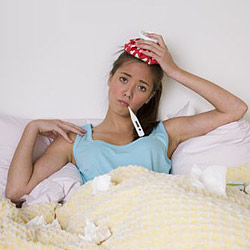As the darker evenings draw in, so does the inescapable feeling of depression, exhaustion and anxiety, for those suffering with Seasonal Affective Disorder.
I watch my friend Alexis experience this every year – as the season changes and summer passes, her mood nosedives. She struggles to get out of bed in the morning, and both her concentration levels and confidence crash.
Seasonal Affective Disorder is a type of depression correlating with seasonal change, thought to be linked with the reduced light that winter brings. According to Bupa, SAD hits 3% of the UK population and is four times more likely to affect women than men.
A syndrome which strikes as soon as summer ends and sunlight diminishes, a low mood every autumn and winter specifically can be a sign.
Seasonal Affective Disorder symptoms
Also described as the winter blues, according to Alexis, this really doesn’t cover the true debilitating extent of SAD. Symptoms include depression, fatigue, low self-esteem, withdrawing from social events and commitments, tearfulness, reduced libido and anxiety. In her experience, the fatigue is crushing; a tiredness which seriously restricts day-to-day activities.
Simple and free acts of self-care to try if you’re feeling anxious
Although primarily linked to low serotonin levels and a disrupted body clock, a physical illness or trauma can trigger SAD too. It could also be attributed to higher amounts of melatonin being produced in the night and later into the morning, resulting in a greater desire for sleep. With light being a natural stimulant, once this starts reducing, natural circadian rhythms are dramatically disrupted. Because of where we are positioned, those of us in the UK and Ireland undergo substantial changes in light due to being in the higher latitudes of the northern hempishere.

Alexis has learnt to manage her condition by being aware of certain restrictions and the importance of simple self-care. In addition, recognised treatment for SAD includes Cognitive Behavioural Therapy, antidepressants and light therapy.
Seasonal Affective Disorder treatments
Light therapy specialists, Lumie, have been developing products to help with the effects of SAD for 25 years. PR Manager Malgo Dzierugo explains, “the end of British Summer Time also marks the start of colder and gloomier days, which in turn means less motivation and productivity as well as seasonal mood changes.”
I made the bold move to come off my anxiety medication, here’s exactly what happened…
With light therapy products including body clocks simulating dawn for an easier wakeup and lights to boost mood and energy levels, Lumie have thoroughly researched what works best for those with the condition.
Malgo continues: “Bright light therapy (BLT) is a fairly well-known way to help SAD sufferers alleviate depressive symptoms. For best results, we typically recommend using both sleep/wakeup lights as well as SAD lamps, since many SAD sufferers really struggle to get up in the morning”.
Mental health charity MIND notes the importance of a strong network and perhaps looking into support groups to share your story with those experiencing similar symptoms. In addition to light therapy, being outside and exercising is thought to help with the dreaded lethargy, as well as focusing on a healthy diet.
It is well documented that SAD sufferers crave carbohydrates, and MIND emphasise how vital it is to balance carbs like pasta and potatoes with fresh fruit and veg, so you avoid feeling even more sluggish. The GP advised Alexis begins taking vitamins B12 and D, to encourage a further boost.
Having an impact on Alexis’ social life, relationships and performance at work, realising where the problem lay was a key turning point for her. As she explained to me, at least knowing the reason why depression hits her so hard at this time of year and all energy goes out the window, offers a glimmer of control and hope.
Ditching those who didn’t try to understand SAD and offered little sympathy was another key self-care step, with Alexis choosing to pull close those pals who did get it. A constant need to justify hideous symptoms and overwhelming depression is the last thing any girl needs.
We all complain about losing our mojo on dark and dreary days, and it’s not uncommon to feel lethargic during the colder seasons. But if you suspect something more serious is going on, and these symptoms of SAD resonate, contact your doctor.



